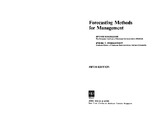Multiple regression: chapter 9
| dc.contributor.author | Makridakis, Spyros | |
| dc.contributor.author | Wheelright, Steven | |
| dc.date.accessioned | 2015-12-16T14:53:15Z | |
| dc.date.available | 2015-12-16T14:53:15Z | |
| dc.date.issued | 1989 | |
| dc.identifier.isbn | 978-0471600633 | |
| dc.identifier.uri | http://hdl.handle.net/11728/6670 | |
| dc.description.abstract | In Chapter 8 simple regression and correlation were introduced and discussed. In simple regression the basic proposition is that an independent variable can be used to predict the value of some dependent variable (the quantity to be forecast) on the basis of a linear relationship between the two variables. In the major example in that chapter the variable to be forecast was the number of orders received daily by a mail-order house. The independent variable on which that forecast was based was the weight of all mail for that day. In many decision-making situations more than one variable can be used to explain or forecast a certain dependent variable. For example, in the mail-order situation the day of the week, as weil as the weight of mail received, might be used to predict the number of orders. | en_UK |
| dc.language.iso | en | en_UK |
| dc.publisher | Wiley, John & Sons | en_UK |
| dc.rights | © 1989, Wiley, John & Sons | en_UK |
| dc.rights.uri | http://creativecommons.org/licenses/by-nc-nd/4.0/ | en_UK |
| dc.subject | Economic forecasting | en_UK |
| dc.subject | methodology | en_UK |
| dc.subject | Business forecasting | en_UK |
| dc.title | Multiple regression: chapter 9 | en_UK |
| dc.title.alternative | Forecasting Methods for Management 5th Edition | en_UK |
| dc.type | Book chapter | en_UK |
Files in this item
This item appears in the following Collection(s)
-
Book chapters26
Κεφάλαια βιβλίων


